Analyzing the Impact of Globalization on the Retail Sector: A Report
VerifiedAdded on 2020/07/22
|7
|1642
|29
Report
AI Summary
This report examines the profound impact of globalization on the retail sector. It begins with an introduction to globalization and its effects on business expansion, economic growth, and consumer choices. The assessment section delves into how globalization facilitates business growth through increased sales, market share, and foreign direct investment. It explores various perspectives on globalization from business owners, highlighting its positive effects on market development and consumer access to a wide range of products. The report then analyzes both the positive and negative impacts of globalization on the global economy, including increased competition, tax policies, and the challenges faced by local retailers. It further discusses the elements of globalization such as trade agreements, capital flow, and technology transfer. The report applies the world system theory to categorize countries and understand the dynamics of the retail sector within core, semi-periphery, and periphery economies. It concludes by summarizing the key findings, emphasizing the dual nature of globalization's impact on the retail sector, encompassing both opportunities for growth and challenges related to competition and economic policies. Finally, it provides a list of references used in the report.
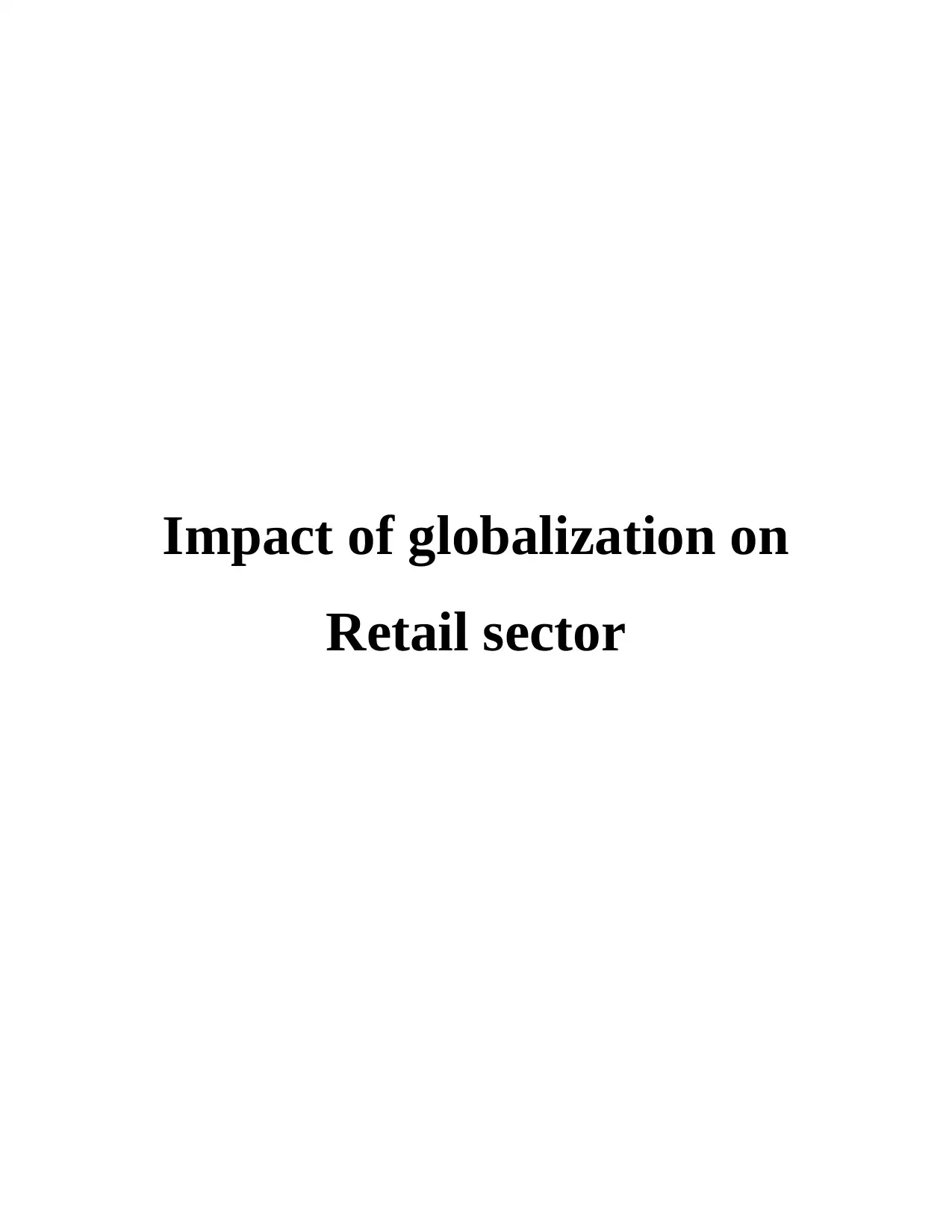
Impact of globalization on
Retail sector
Retail sector
Paraphrase This Document
Need a fresh take? Get an instant paraphrase of this document with our AI Paraphraser
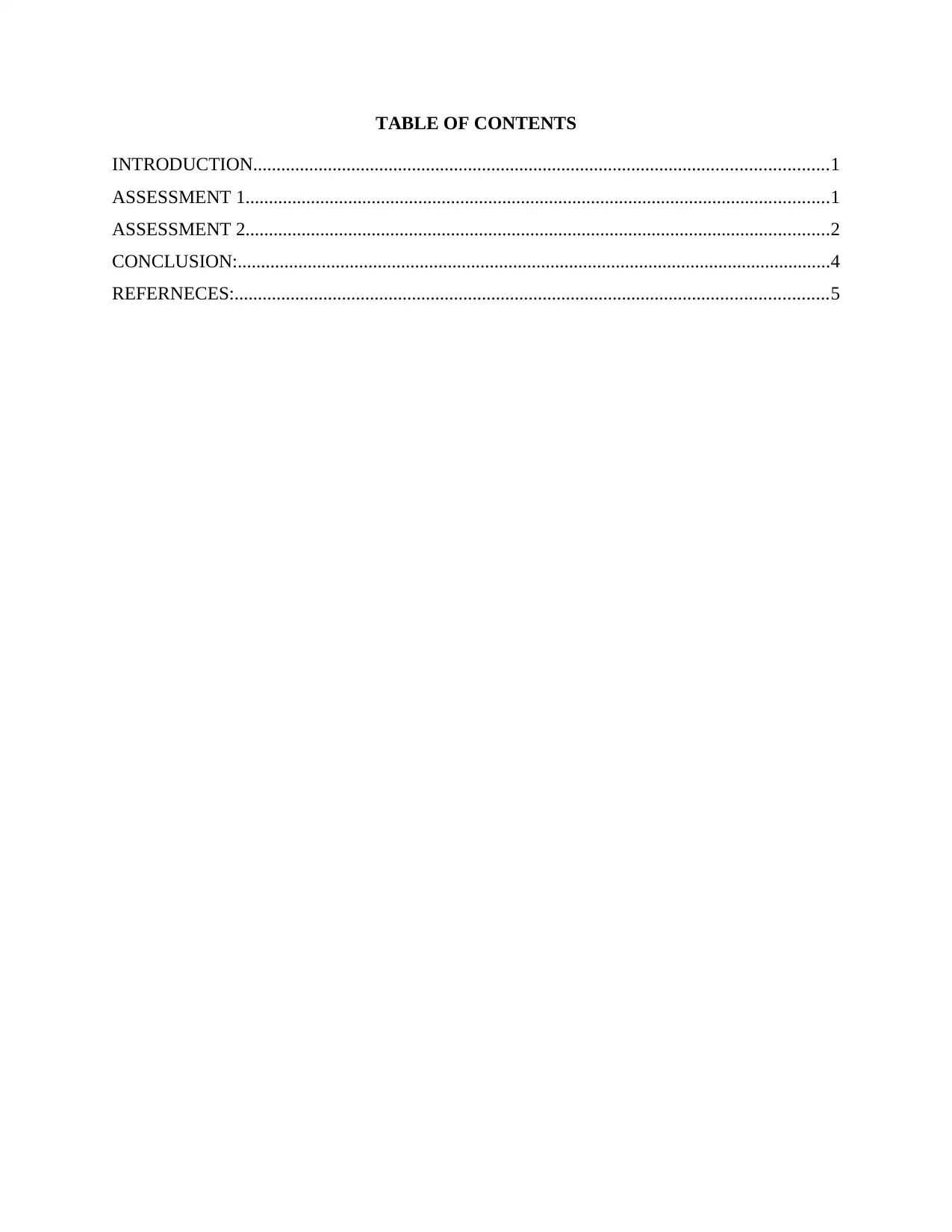
TABLE OF CONTENTS
INTRODUCTION...........................................................................................................................1
ASSESSMENT 1.............................................................................................................................1
ASSESSMENT 2.............................................................................................................................2
CONCLUSION:...............................................................................................................................4
REFERNECES:...............................................................................................................................5
INTRODUCTION...........................................................................................................................1
ASSESSMENT 1.............................................................................................................................1
ASSESSMENT 2.............................................................................................................................2
CONCLUSION:...............................................................................................................................4
REFERNECES:...............................................................................................................................5
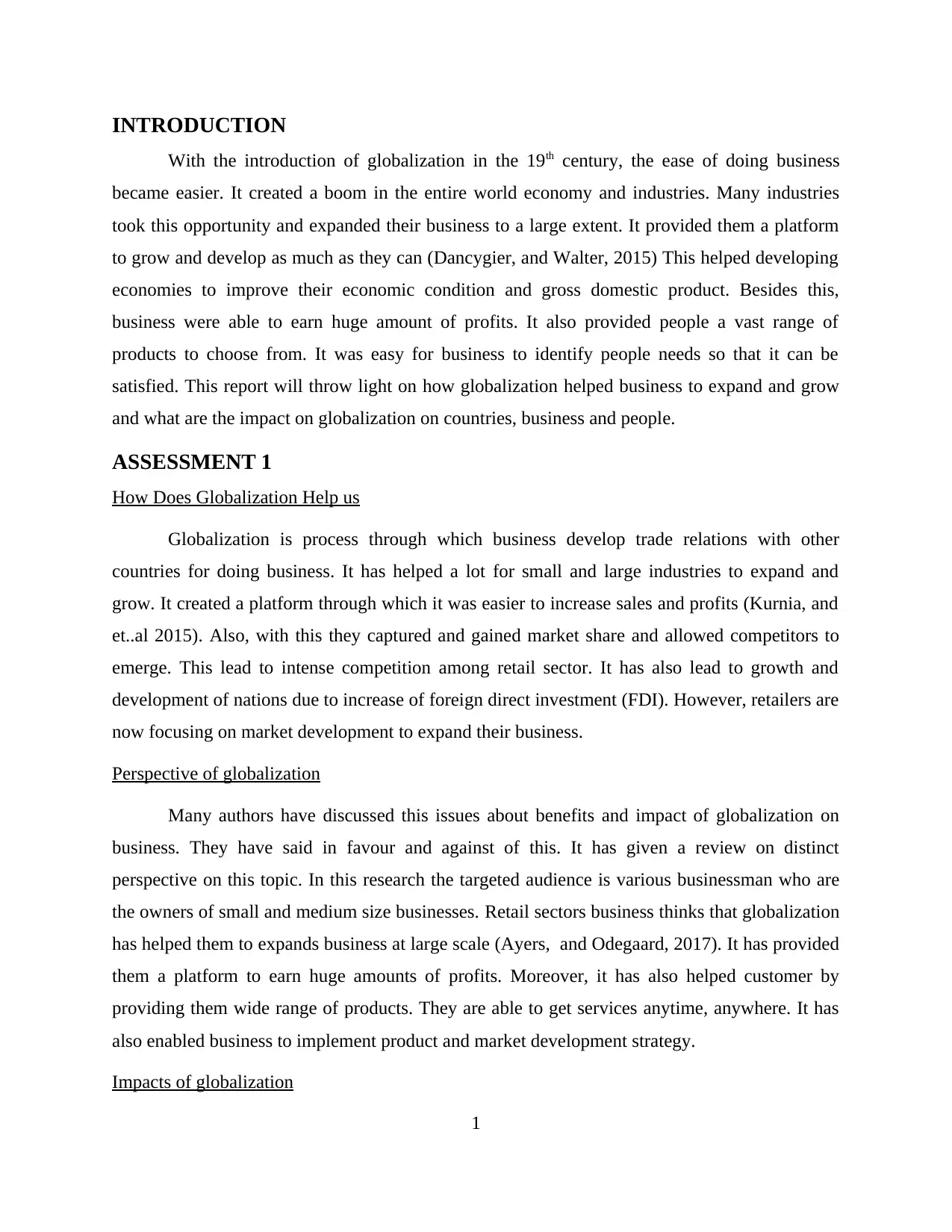
INTRODUCTION
With the introduction of globalization in the 19th century, the ease of doing business
became easier. It created a boom in the entire world economy and industries. Many industries
took this opportunity and expanded their business to a large extent. It provided them a platform
to grow and develop as much as they can (Dancygier, and Walter, 2015) This helped developing
economies to improve their economic condition and gross domestic product. Besides this,
business were able to earn huge amount of profits. It also provided people a vast range of
products to choose from. It was easy for business to identify people needs so that it can be
satisfied. This report will throw light on how globalization helped business to expand and grow
and what are the impact on globalization on countries, business and people.
ASSESSMENT 1
How Does Globalization Help us
Globalization is process through which business develop trade relations with other
countries for doing business. It has helped a lot for small and large industries to expand and
grow. It created a platform through which it was easier to increase sales and profits (Kurnia, and
et..al 2015). Also, with this they captured and gained market share and allowed competitors to
emerge. This lead to intense competition among retail sector. It has also lead to growth and
development of nations due to increase of foreign direct investment (FDI). However, retailers are
now focusing on market development to expand their business.
Perspective of globalization
Many authors have discussed this issues about benefits and impact of globalization on
business. They have said in favour and against of this. It has given a review on distinct
perspective on this topic. In this research the targeted audience is various businessman who are
the owners of small and medium size businesses. Retail sectors business thinks that globalization
has helped them to expands business at large scale (Ayers, and Odegaard, 2017). It has provided
them a platform to earn huge amounts of profits. Moreover, it has also helped customer by
providing them wide range of products. They are able to get services anytime, anywhere. It has
also enabled business to implement product and market development strategy.
Impacts of globalization
1
With the introduction of globalization in the 19th century, the ease of doing business
became easier. It created a boom in the entire world economy and industries. Many industries
took this opportunity and expanded their business to a large extent. It provided them a platform
to grow and develop as much as they can (Dancygier, and Walter, 2015) This helped developing
economies to improve their economic condition and gross domestic product. Besides this,
business were able to earn huge amount of profits. It also provided people a vast range of
products to choose from. It was easy for business to identify people needs so that it can be
satisfied. This report will throw light on how globalization helped business to expand and grow
and what are the impact on globalization on countries, business and people.
ASSESSMENT 1
How Does Globalization Help us
Globalization is process through which business develop trade relations with other
countries for doing business. It has helped a lot for small and large industries to expand and
grow. It created a platform through which it was easier to increase sales and profits (Kurnia, and
et..al 2015). Also, with this they captured and gained market share and allowed competitors to
emerge. This lead to intense competition among retail sector. It has also lead to growth and
development of nations due to increase of foreign direct investment (FDI). However, retailers are
now focusing on market development to expand their business.
Perspective of globalization
Many authors have discussed this issues about benefits and impact of globalization on
business. They have said in favour and against of this. It has given a review on distinct
perspective on this topic. In this research the targeted audience is various businessman who are
the owners of small and medium size businesses. Retail sectors business thinks that globalization
has helped them to expands business at large scale (Ayers, and Odegaard, 2017). It has provided
them a platform to earn huge amounts of profits. Moreover, it has also helped customer by
providing them wide range of products. They are able to get services anytime, anywhere. It has
also enabled business to implement product and market development strategy.
Impacts of globalization
1
⊘ This is a preview!⊘
Do you want full access?
Subscribe today to unlock all pages.

Trusted by 1+ million students worldwide
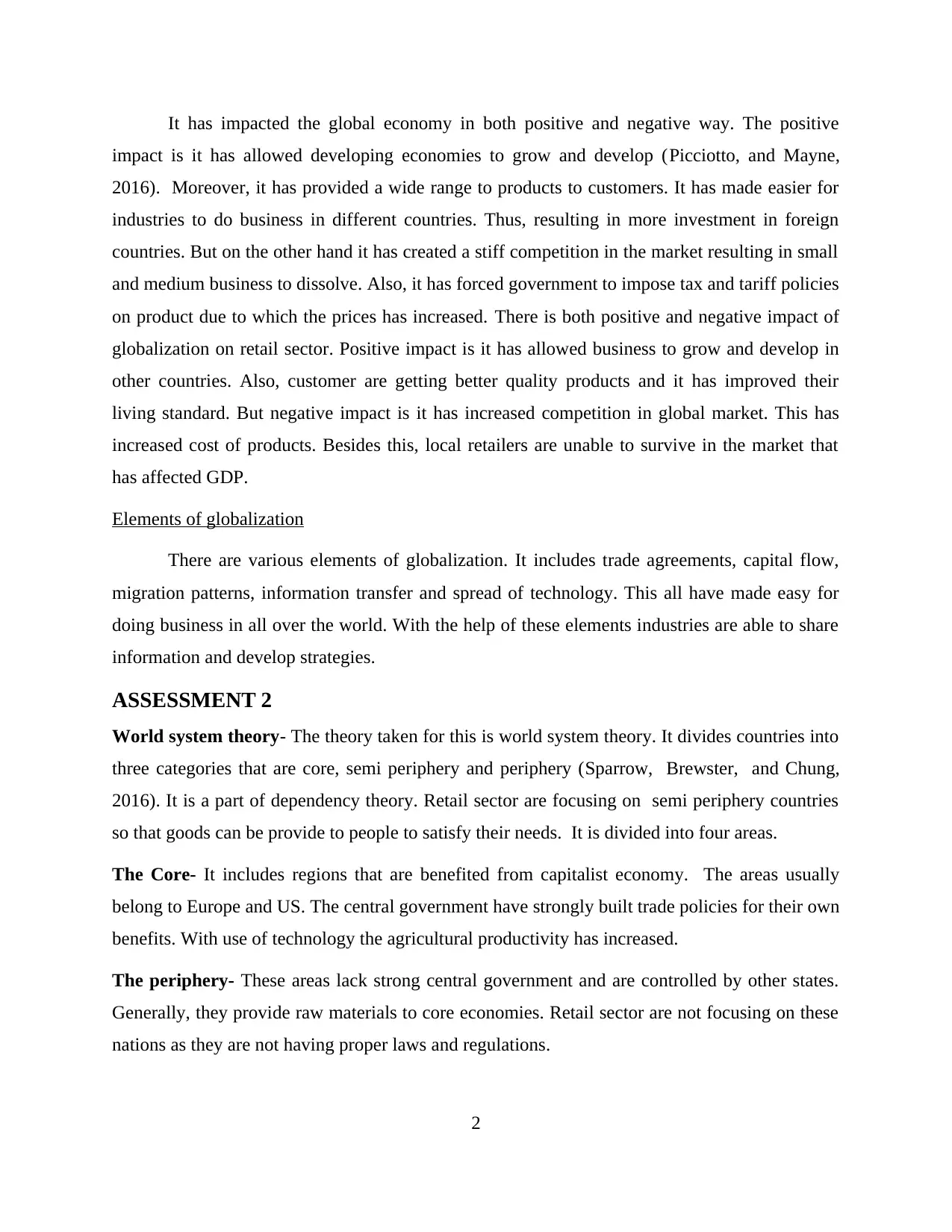
It has impacted the global economy in both positive and negative way. The positive
impact is it has allowed developing economies to grow and develop (Picciotto, and Mayne,
2016). Moreover, it has provided a wide range to products to customers. It has made easier for
industries to do business in different countries. Thus, resulting in more investment in foreign
countries. But on the other hand it has created a stiff competition in the market resulting in small
and medium business to dissolve. Also, it has forced government to impose tax and tariff policies
on product due to which the prices has increased. There is both positive and negative impact of
globalization on retail sector. Positive impact is it has allowed business to grow and develop in
other countries. Also, customer are getting better quality products and it has improved their
living standard. But negative impact is it has increased competition in global market. This has
increased cost of products. Besides this, local retailers are unable to survive in the market that
has affected GDP.
Elements of globalization
There are various elements of globalization. It includes trade agreements, capital flow,
migration patterns, information transfer and spread of technology. This all have made easy for
doing business in all over the world. With the help of these elements industries are able to share
information and develop strategies.
ASSESSMENT 2
World system theory- The theory taken for this is world system theory. It divides countries into
three categories that are core, semi periphery and periphery (Sparrow, Brewster, and Chung,
2016). It is a part of dependency theory. Retail sector are focusing on semi periphery countries
so that goods can be provide to people to satisfy their needs. It is divided into four areas.
The Core- It includes regions that are benefited from capitalist economy. The areas usually
belong to Europe and US. The central government have strongly built trade policies for their own
benefits. With use of technology the agricultural productivity has increased.
The periphery- These areas lack strong central government and are controlled by other states.
Generally, they provide raw materials to core economies. Retail sector are not focusing on these
nations as they are not having proper laws and regulations.
2
impact is it has allowed developing economies to grow and develop (Picciotto, and Mayne,
2016). Moreover, it has provided a wide range to products to customers. It has made easier for
industries to do business in different countries. Thus, resulting in more investment in foreign
countries. But on the other hand it has created a stiff competition in the market resulting in small
and medium business to dissolve. Also, it has forced government to impose tax and tariff policies
on product due to which the prices has increased. There is both positive and negative impact of
globalization on retail sector. Positive impact is it has allowed business to grow and develop in
other countries. Also, customer are getting better quality products and it has improved their
living standard. But negative impact is it has increased competition in global market. This has
increased cost of products. Besides this, local retailers are unable to survive in the market that
has affected GDP.
Elements of globalization
There are various elements of globalization. It includes trade agreements, capital flow,
migration patterns, information transfer and spread of technology. This all have made easy for
doing business in all over the world. With the help of these elements industries are able to share
information and develop strategies.
ASSESSMENT 2
World system theory- The theory taken for this is world system theory. It divides countries into
three categories that are core, semi periphery and periphery (Sparrow, Brewster, and Chung,
2016). It is a part of dependency theory. Retail sector are focusing on semi periphery countries
so that goods can be provide to people to satisfy their needs. It is divided into four areas.
The Core- It includes regions that are benefited from capitalist economy. The areas usually
belong to Europe and US. The central government have strongly built trade policies for their own
benefits. With use of technology the agricultural productivity has increased.
The periphery- These areas lack strong central government and are controlled by other states.
Generally, they provide raw materials to core economies. Retail sector are not focusing on these
nations as they are not having proper laws and regulations.
2
Paraphrase This Document
Need a fresh take? Get an instant paraphrase of this document with our AI Paraphraser
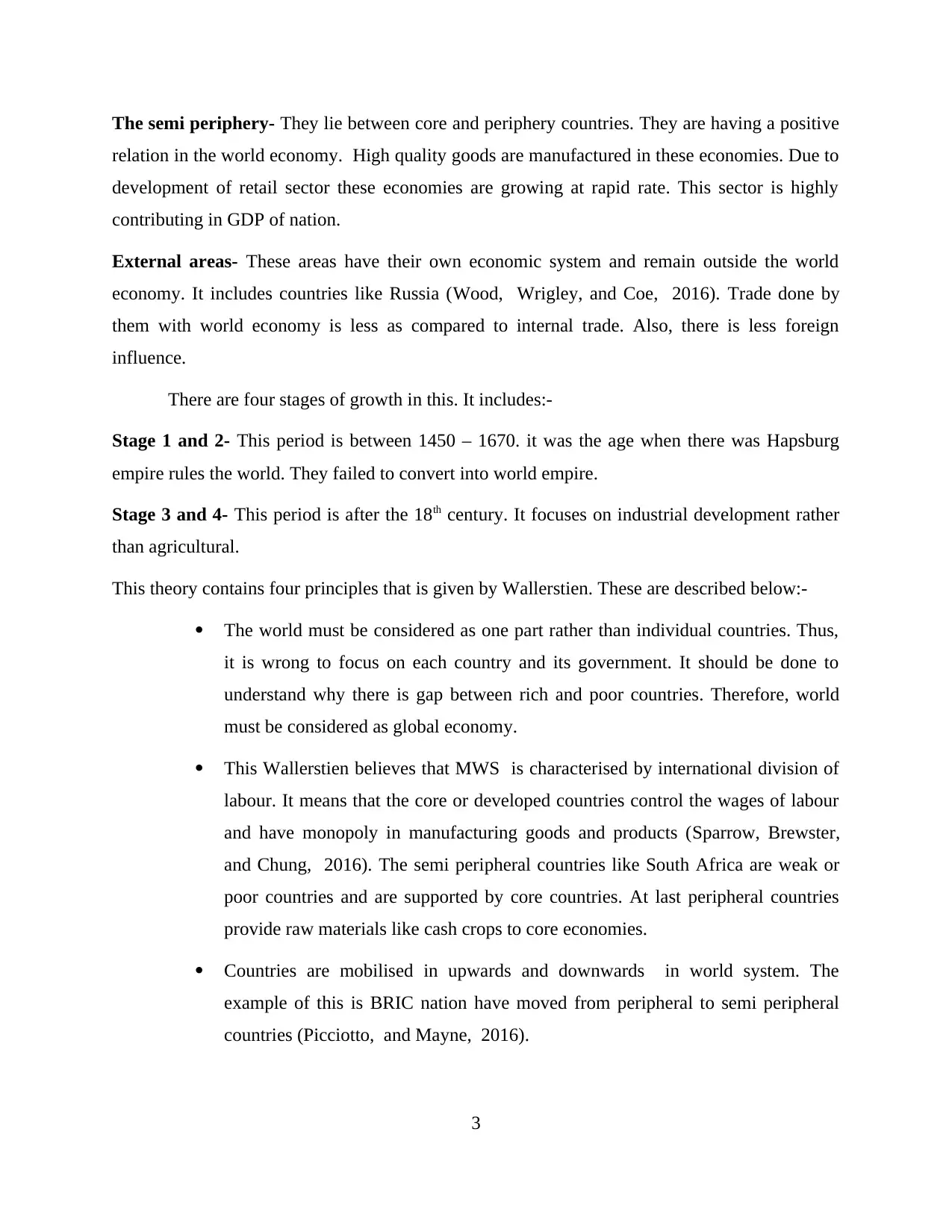
The semi periphery- They lie between core and periphery countries. They are having a positive
relation in the world economy. High quality goods are manufactured in these economies. Due to
development of retail sector these economies are growing at rapid rate. This sector is highly
contributing in GDP of nation.
External areas- These areas have their own economic system and remain outside the world
economy. It includes countries like Russia (Wood, Wrigley, and Coe, 2016). Trade done by
them with world economy is less as compared to internal trade. Also, there is less foreign
influence.
There are four stages of growth in this. It includes:-
Stage 1 and 2- This period is between 1450 – 1670. it was the age when there was Hapsburg
empire rules the world. They failed to convert into world empire.
Stage 3 and 4- This period is after the 18th century. It focuses on industrial development rather
than agricultural.
This theory contains four principles that is given by Wallerstien. These are described below:-
The world must be considered as one part rather than individual countries. Thus,
it is wrong to focus on each country and its government. It should be done to
understand why there is gap between rich and poor countries. Therefore, world
must be considered as global economy.
This Wallerstien believes that MWS is characterised by international division of
labour. It means that the core or developed countries control the wages of labour
and have monopoly in manufacturing goods and products (Sparrow, Brewster,
and Chung, 2016). The semi peripheral countries like South Africa are weak or
poor countries and are supported by core countries. At last peripheral countries
provide raw materials like cash crops to core economies.
Countries are mobilised in upwards and downwards in world system. The
example of this is BRIC nation have moved from peripheral to semi peripheral
countries (Picciotto, and Mayne, 2016).
3
relation in the world economy. High quality goods are manufactured in these economies. Due to
development of retail sector these economies are growing at rapid rate. This sector is highly
contributing in GDP of nation.
External areas- These areas have their own economic system and remain outside the world
economy. It includes countries like Russia (Wood, Wrigley, and Coe, 2016). Trade done by
them with world economy is less as compared to internal trade. Also, there is less foreign
influence.
There are four stages of growth in this. It includes:-
Stage 1 and 2- This period is between 1450 – 1670. it was the age when there was Hapsburg
empire rules the world. They failed to convert into world empire.
Stage 3 and 4- This period is after the 18th century. It focuses on industrial development rather
than agricultural.
This theory contains four principles that is given by Wallerstien. These are described below:-
The world must be considered as one part rather than individual countries. Thus,
it is wrong to focus on each country and its government. It should be done to
understand why there is gap between rich and poor countries. Therefore, world
must be considered as global economy.
This Wallerstien believes that MWS is characterised by international division of
labour. It means that the core or developed countries control the wages of labour
and have monopoly in manufacturing goods and products (Sparrow, Brewster,
and Chung, 2016). The semi peripheral countries like South Africa are weak or
poor countries and are supported by core countries. At last peripheral countries
provide raw materials like cash crops to core economies.
Countries are mobilised in upwards and downwards in world system. The
example of this is BRIC nation have moved from peripheral to semi peripheral
countries (Picciotto, and Mayne, 2016).
3
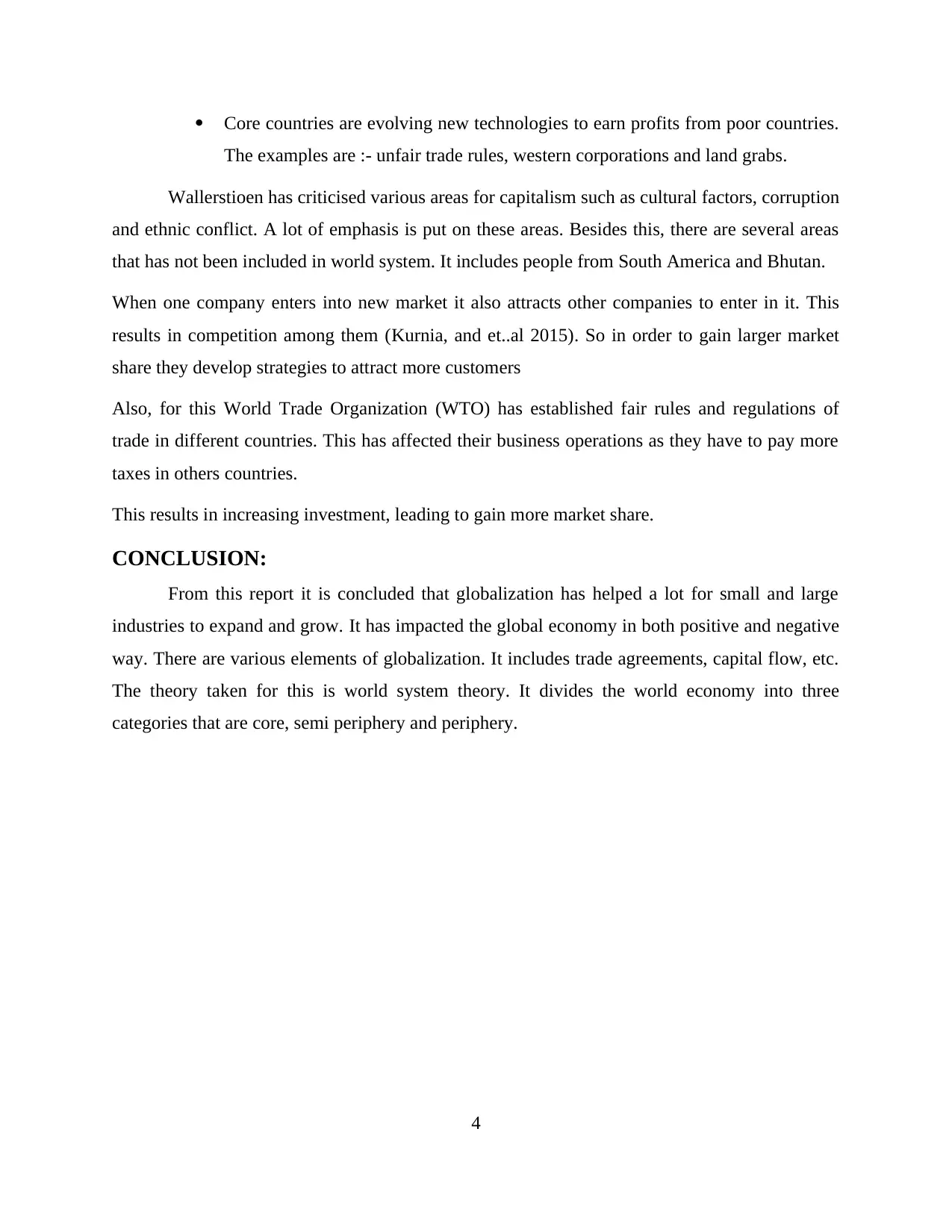
Core countries are evolving new technologies to earn profits from poor countries.
The examples are :- unfair trade rules, western corporations and land grabs.
Wallerstioen has criticised various areas for capitalism such as cultural factors, corruption
and ethnic conflict. A lot of emphasis is put on these areas. Besides this, there are several areas
that has not been included in world system. It includes people from South America and Bhutan.
When one company enters into new market it also attracts other companies to enter in it. This
results in competition among them (Kurnia, and et..al 2015). So in order to gain larger market
share they develop strategies to attract more customers
Also, for this World Trade Organization (WTO) has established fair rules and regulations of
trade in different countries. This has affected their business operations as they have to pay more
taxes in others countries.
This results in increasing investment, leading to gain more market share.
CONCLUSION:
From this report it is concluded that globalization has helped a lot for small and large
industries to expand and grow. It has impacted the global economy in both positive and negative
way. There are various elements of globalization. It includes trade agreements, capital flow, etc.
The theory taken for this is world system theory. It divides the world economy into three
categories that are core, semi periphery and periphery.
4
The examples are :- unfair trade rules, western corporations and land grabs.
Wallerstioen has criticised various areas for capitalism such as cultural factors, corruption
and ethnic conflict. A lot of emphasis is put on these areas. Besides this, there are several areas
that has not been included in world system. It includes people from South America and Bhutan.
When one company enters into new market it also attracts other companies to enter in it. This
results in competition among them (Kurnia, and et..al 2015). So in order to gain larger market
share they develop strategies to attract more customers
Also, for this World Trade Organization (WTO) has established fair rules and regulations of
trade in different countries. This has affected their business operations as they have to pay more
taxes in others countries.
This results in increasing investment, leading to gain more market share.
CONCLUSION:
From this report it is concluded that globalization has helped a lot for small and large
industries to expand and grow. It has impacted the global economy in both positive and negative
way. There are various elements of globalization. It includes trade agreements, capital flow, etc.
The theory taken for this is world system theory. It divides the world economy into three
categories that are core, semi periphery and periphery.
4
⊘ This is a preview!⊘
Do you want full access?
Subscribe today to unlock all pages.

Trusted by 1+ million students worldwide
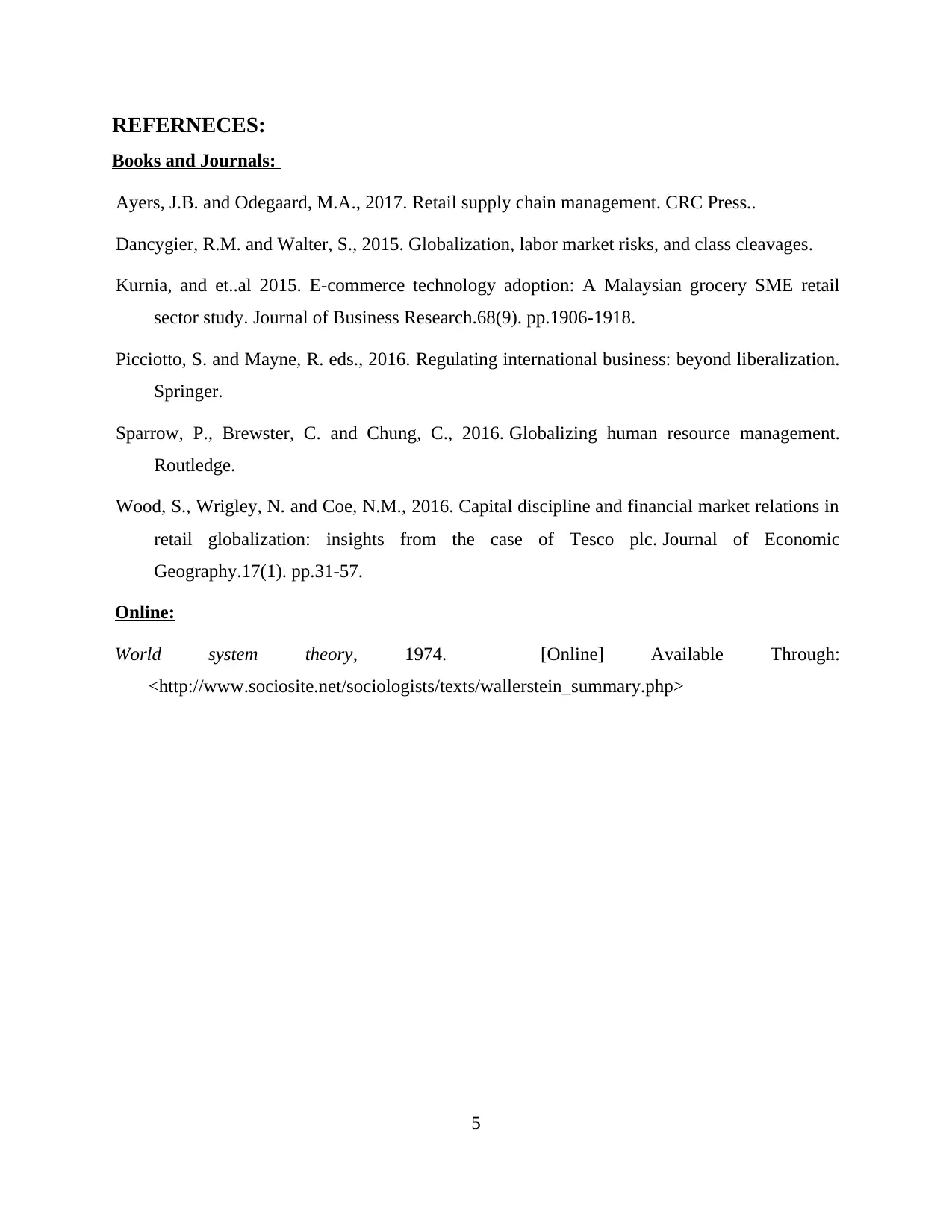
REFERNECES:
Books and Journals:
Ayers, J.B. and Odegaard, M.A., 2017. Retail supply chain management. CRC Press..
Dancygier, R.M. and Walter, S., 2015. Globalization, labor market risks, and class cleavages.
Kurnia, and et..al 2015. E-commerce technology adoption: A Malaysian grocery SME retail
sector study. Journal of Business Research.68(9). pp.1906-1918.
Picciotto, S. and Mayne, R. eds., 2016. Regulating international business: beyond liberalization.
Springer.
Sparrow, P., Brewster, C. and Chung, C., 2016. Globalizing human resource management.
Routledge.
Wood, S., Wrigley, N. and Coe, N.M., 2016. Capital discipline and financial market relations in
retail globalization: insights from the case of Tesco plc. Journal of Economic
Geography.17(1). pp.31-57.
Online:
World system theory, 1974. [Online] Available Through:
<http://www.sociosite.net/sociologists/texts/wallerstein_summary.php>
5
Books and Journals:
Ayers, J.B. and Odegaard, M.A., 2017. Retail supply chain management. CRC Press..
Dancygier, R.M. and Walter, S., 2015. Globalization, labor market risks, and class cleavages.
Kurnia, and et..al 2015. E-commerce technology adoption: A Malaysian grocery SME retail
sector study. Journal of Business Research.68(9). pp.1906-1918.
Picciotto, S. and Mayne, R. eds., 2016. Regulating international business: beyond liberalization.
Springer.
Sparrow, P., Brewster, C. and Chung, C., 2016. Globalizing human resource management.
Routledge.
Wood, S., Wrigley, N. and Coe, N.M., 2016. Capital discipline and financial market relations in
retail globalization: insights from the case of Tesco plc. Journal of Economic
Geography.17(1). pp.31-57.
Online:
World system theory, 1974. [Online] Available Through:
<http://www.sociosite.net/sociologists/texts/wallerstein_summary.php>
5
1 out of 7
Related Documents
Your All-in-One AI-Powered Toolkit for Academic Success.
+13062052269
info@desklib.com
Available 24*7 on WhatsApp / Email
![[object Object]](/_next/static/media/star-bottom.7253800d.svg)
Unlock your academic potential
Copyright © 2020–2025 A2Z Services. All Rights Reserved. Developed and managed by ZUCOL.





